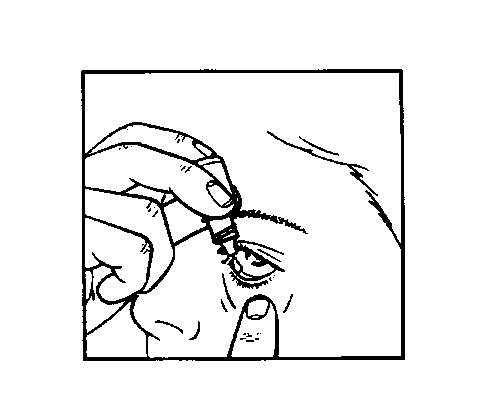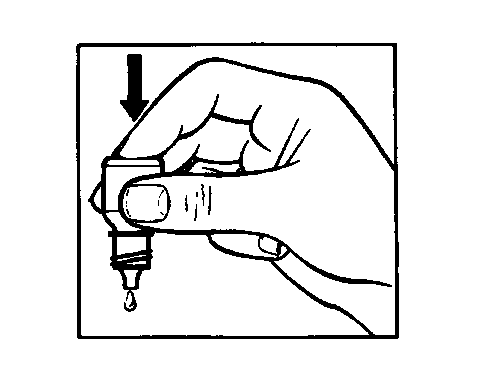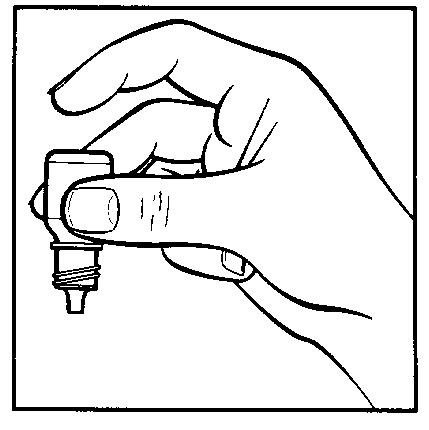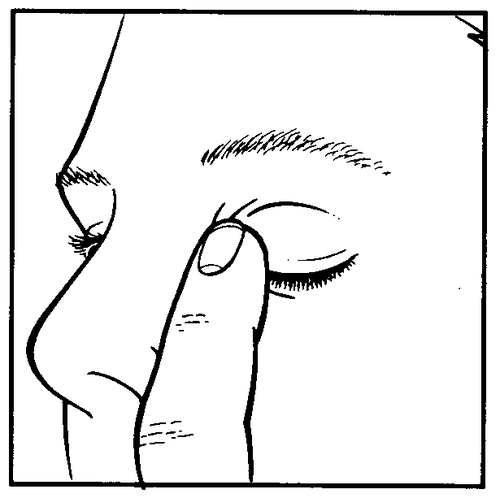
Tobrex
Ask a doctor about a prescription for Tobrex

How to use Tobrex
Leaflet attached to the packaging: patient information
Tobrex, 3 mg/ml, eye drops, solution
(Tobramycin)
Read the leaflet carefully before using the medicine, as it contains important information for the patient.
- Keep this leaflet, you may need to read it again.
- If you have any further questions, ask your doctor or pharmacist.
- This medicine has been prescribed for a specific person. Do not pass it on to others. The medicine may harm another person, even if their symptoms are the same.
- If the patient experiences any side effects, including any side effects not listed in this leaflet, they should tell their doctor or pharmacist. See section 4.
Table of contents of the leaflet:
- 1. What is Tobrex and what is it used for
- 2. Important information before using Tobrex
- 3. How to use Tobrex
- 4. Possible side effects
- 5. How to store Tobrex
- 6. Contents of the pack and other information
1. What is Tobrex and what is it used for
Tobrex is an antibiotic that acts on many species of microorganisms that can infect the eye.
Tobrex is intended for use in the treatment of external eye infections and their surroundings in adults and children over 1 year of age, caused by bacteria sensitive to its active substance - tobramycin.
2. Important information before using Tobrex
When not to use Tobrex:
- -if the patient is allergicto tobramycin or any of the other ingredients of this medicine (listed in section 6).
Warnings and precautions:
Before starting to use Tobrex, the patient should discuss it with their doctor or pharmacist:
- -if the patient experiences allergic reactions after using Tobrex, they should stop using the medicine and consult their doctor immediately (see section 4). Hypersensitivity symptoms may vary in severity: from local itching or skin redness to severe allergic reactions (anaphylactic reaction) or severe skin reactions. Such allergic reactions may occur when using other topical or systemic antibiotics from the same group (aminoglycosides).
- -if the patient is using other antibiotic therapy while using Tobrex, they should consult their doctor.
- -if the patient has or is suspected of having myasthenia or Parkinson's disease, they should consult their doctor. Antibiotics from this group may increase muscle weakness.
- -if the patient's symptoms worsen or recur, they should consult their doctor. If the patient uses Tobrex for a longer period, they may become more susceptible to eye infections.
- if the patient experiences persistent corneal ulceration while using Tobrex, they should consult their doctor as soon as possible, as this may be a sign of a fungal eye infection.
Tobrex and other medicines
The patient should tell their doctor or pharmacist about all medicines they are taking, have recently taken, or plan to take.
If the patient is using other eye drops or ointments, they should leave at least a 5-minute interval between administrations of the different medicines. Eye ointments should be used last.
Pregnancy and breastfeeding
If the patient is pregnant or breastfeeding, thinks they may be pregnant, or plans to have a child, they should consult their doctor before using this medicine.
Pregnancy
Tobrex may only be used during pregnancy if it is absolutely necessary.
Breastfeeding
Using Tobrex is not recommended during breastfeeding. The doctor will decide whether to continue or stop breastfeeding or continue or stop treatment, taking into account the benefits of breastfeeding for the baby and the benefits of treatment for the mother.
Driving and using machines
Tobrex eye drops have no or negligible influence on the ability to drive and use machines.
For a while after using Tobrex eye drops, vision may be blurred. The patient should not drive or use machines until this symptom disappears.
Tobrex eye drops contain benzalkonium chloride
The medicine contains 0.1 mg of benzalkonium chloride per milliliter (0.1 mg/ml).
Benzalkonium chloride may be absorbed by soft contact lenses and change their color. The patient should remove their contact lenses before using the drops and wait at least 15 minutes before putting them back in.
Benzalkonium chloride may also cause eye irritation, especially in people with dry eye syndrome or corneal disorders (the transparent layer at the front of the eye). If the patient experiences any abnormal sensations in the eye, stinging, or pain in the eye after using the medicine, they should consult their doctor.
3. How to use Tobrex
This medicine should always be used exactly as the doctor has instructed. If the patient is unsure, they should ask their doctor or pharmacist.
In mild or moderate infections, one to two drops are instilled into the conjunctival sac of the infected eye(s) every four hours.
In severe cases, one to two drops are instilled into the conjunctival sac of the infected eye(s) every hour until improvement is achieved. Then the medicine should be used less frequently until the end of treatment.
Usually, the medicine is used for 7 to 10 days. The patient should use the medicine for as long as the doctor has instructed.
After instillation, the patient should gently close their eyelid and press the corner of their eye near the nose.
This helps reduce the absorption of the medicinal product into the bloodstream and its systemic effects.
Use in children
Tobrex eye drops may be used in children over 1 year of age at the same dose as in adults. The maximum number of drops that can be administered in 24 hours is 14 drops for children from 1 to 2 years of age and 46 drops for children from 2 to 12 years of age.If the patient is unsure, they should ask their doctor. The safety and efficacy of using the medicine in children under 1 year of age have not been established, and no data are available for such use.
Use in the elderly
In the elderly, the same dose is used as in adults.
Use in patients with liver or kidney disorders
The safety and efficacy of using Tobrex in patients with liver or kidney disorders have not been established.
Method of administration
Tobrex is onlyintended for instillation into the eye.




1
2
3
4
Method of administration
- 1. Prepare the Tobrex bottle and a mirror.
- 2. Wash your hands.
- 3. Remove the cap. If the protective collar is loose after removing the cap, it should be discarded before using the medicine.
- 4. Hold the bottle in your hand and turn it upside down, holding it with your thumb and middle finger (picture 1).
- 5. Tilt your head back. With a clean finger, pull down the lower eyelid to create a "pocket" between the eyeball and the eyelid; the drop should fall into this pocket (picture 2).
- 6. Bring the tip of the bottle close to the eye. You can use a mirror to help.
- 7. Do not touch the dropper to the eye, eyelid, or surrounding areas.This can lead to infection of the drops. Using infected drops can lead to serious complications, even vision loss.
- 8. To release a single drop of Tobrex, gently squeeze the bottom of the bottle (picture 3). If the drop does not fall into the eye, try again.
- 9. After instillation, gently close your eye and press the corner of your eye near the nose (picture 4). This will help prevent the medicine from entering the entire body.
- 10. If using drops in both eyes, repeat the above steps for the second eye.
- 11. Replace the cap immediately after use.
- 12. Use only one bottle at a time.
Using more than the recommended dose of Tobrex
In case of overdose, excess medicine can be rinsed out of the eye with lukewarm water. No side effects are expected. Do not instill additional drops. The next dose should be instilled at the usual time.
Missing a dose of Tobrex
If the patient forgets to use Tobrex eye drops, they should continue treatment by instilling the next dose at the scheduled time. If it is almost time for the next dose, the missed dose should be skipped and the patient should continue with the scheduled dosing regimen. Do not use a double doseto make up for the missed dose.
If the patient is using other eye drops or ointments, they should leave at least a 5-minute interval between administrations of the different medicines. Eye ointments should be used last.
If the patient has any further questions about using this medicine, they should ask their doctor or pharmacist.
4. Possible side effects
Like all medicines, Tobrex can cause side effects, although not everybody gets them.
If the patient experiences allergic reactions, including rash, swelling of the face, lips, tongue, and/or
throat, which may cause difficulty breathing or swallowing, or other serious side effects, they should stop using Tobrex and contact their doctor or the Emergency Department of the nearest hospital immediately.
The following side effects have been observed during treatment with Tobrex eye drops.
Common side effects(may affect up to 1 in 10 people)
Eye symptoms: feeling of discomfort in the eye, eye redness.
Uncommon side effects (may affect up to 1 in 100 people)
Eye symptoms: inflammation of the eye surface, corneal damage, vision disturbances, blurred vision, eyelid redness, eye and eyelid swelling, eye pain, dry eye, eye discharge, eye itching, increased tear production.
General symptoms: allergy (hypersensitivity), headache, hives, skin inflammation, reduced eyelash growth or loss of eyelashes, skin depigmentation, itching, and dry skin.
Frequency not known (frequency cannot be estimated from the available data)
Eye symptoms: eye allergy, eye irritation, eyelid itching.
General symptoms: severe allergic reactions, severe skin reactions (Stevens-Johnson syndrome, erythema multiforme), rash
Reporting side effects
If the patient experiences any side effects, including any side effects not listed in this leaflet
they should tell their doctor or pharmacist.Side effects can be reported directly to the Department of Drug Safety Monitoring of the Office for Registration of Medicinal Products, Medical Devices, and Biocidal Products, Al. Jerozolimskie 181C, 02-222 Warsaw,
Phone: +48 22 49 21 301
Fax: +48 22 49 21 309
Website: https://smz.ezdrowie.gov.pl
Side effects can also be reported to the marketing authorization holder.
By reporting side effects, you can help provide more information on the safety of this medicine.
5. How to store Tobrex
To prevent infections, the drops should not be used after 4 weeks from the first opening of the bottle. The patient should write the date of opening the bottle in the space provided below.
Date of first opening:…………….
The medicine should be kept out of the sight and reach of children.
Store in a temperature below 25°C.
Keep the bottle tightly closed.
Do not use this medicine after the expiry date stated on the packaging after: EXP. The expiry date refers to the last day of the month stated.
Medicines should not be disposed of via wastewater or household waste. The patient should ask their pharmacist how to dispose of medicines they no longer use. This will help protect the environment.
6. Contents of the pack and other information
What Tobrex contains
- The active substance of Tobrex is tobramycin 3 mg/ml.
- The other ingredients are: boric acid (E284), anhydrous sodium sulfate (E514), sodium chloride, tyloxapol, benzalkonium chloride, purified water. The medicine may contain minimal amounts of sulfuric acid or sodium hydroxide (to adjust the pH).
What Tobrex looks like and contents of the pack
1 plastic bottle of 5 ml, placed in a cardboard box.
Marketing authorization holder
Novartis Poland Sp. z o.o.
ul. Marynarska 15
02-674 Warsaw
phone: +48 22 37 54 888
Manufacturer/Importer
Novartis Farmacéutica, S.A.
Gran Via de les Corts Catalanes, 764
08013 Barcelona
Spain
Novartis Manufacturing NV
Rijksweg 14
2870 Puurs-Sint-Amands
Belgium
Siegfried El Masnou, S.A.
Camil Fabra, 58
El Masnou, 08320
Barcelona
Spain
Novartis Pharma GmbH
Roonstrasse 25
90429 Nürnberg
Germany
Date of last revision of the leaflet: 10/2024
- Country of registration
- Active substance
- Prescription requiredYes
- ImporterNovartis Farmacéutica, S.A. Novartis Manufacturing NV Novartis Pharma GmbH SIEGFRIED El Masnou, S.A.
- This information is for reference only and does not constitute medical advice. Always consult a licensed doctor before taking any medication. Oladoctor is not responsible for medical decisions based on this content.
- Alternatives to TobrexDosage form: Ointment, 3 mg/gActive substance: tobramycinPrescription requiredDosage form: Drops, 3 mg/mlActive substance: tobramycinPrescription requiredDosage form: Drops, 3 mg/mlActive substance: tobramycinPrescription required
Alternatives to Tobrex in other countries
The best alternatives with the same active ingredient and therapeutic effect.
Alternative to Tobrex in Ukraine
Alternative to Tobrex in Spain
Online doctors for Tobrex
Discuss dosage, side effects, interactions, contraindications, and prescription renewal for Tobrex – subject to medical assessment and local rules.














